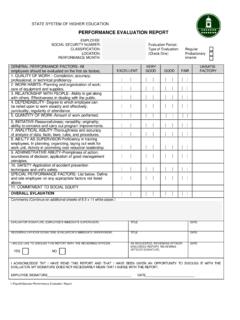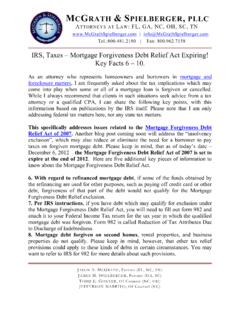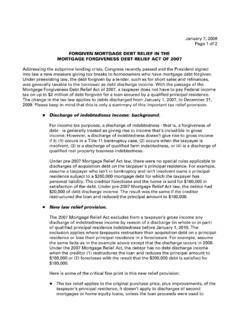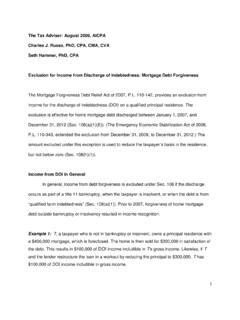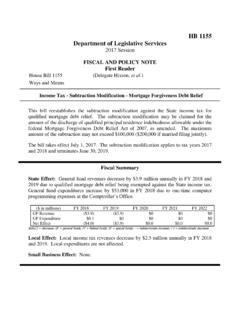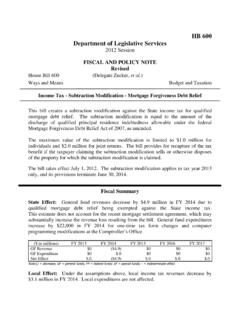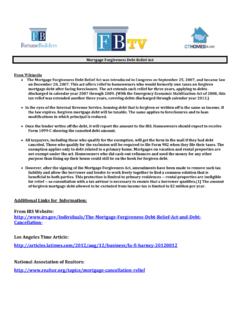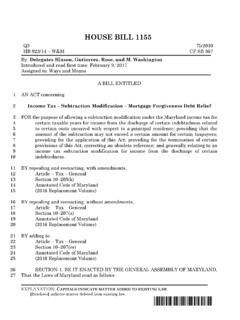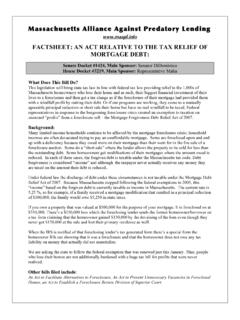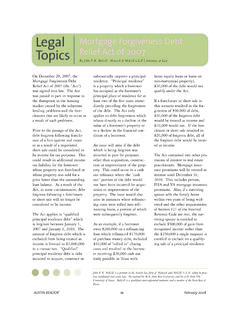Transcription of What Were the Tax Deductions Offered to Help Cure the ...
1 1 What Were the Tax Deductions Offered to Help Cure the Housing Crisis? Did They Work? Teresa K. Lang Auburn University Montgomery Montgomery, Alabama USA Rita C. Jones Troy University Phenix City, Alabama USA Abstract The housing market crisis hit America in 2007, and in response, congress and other authorities responded with several stimulus measures. Two measures were implemented using the Internal Revenue Code: (1) the first-time homebuyer credit and (2) the mortgage forgiveness debt relief and debt cancellation act. This paper reviews home sales data to evaluate the effectiveness of these tax incentives. Based on the findings, this research indicates there was little or no effect on the housing market. Introduction The last decade in the United States has been marred by numerous financial challenges. Economists refer to the housing crisis in this period as the worst financial crisis since the Great Depression (Markels, 2008).
2 From falling stock prices to high unemployment, the country has been on a downward economic spiral. In the past, the government has tried to help the economy by initiating tax credits and Deductions to stimulate a particular area of the economy. The most recent downturn was no exception. Many people claim they know the reasons causing the housing crisis, and like any other highly publicized financial topic, there were, and are, some farfetched ideas on how the country could overcome this particular crisis and rebuild the housing market. Politicians decided to use the Internal Revenue Code in their attempt to address the problem. Temporary tax Deductions and tax credits were devised to encourage people to re-enter the housing market. Perhaps the most well-known tax provision is commonly referred to as the First-Time Homebuyer Credit (FTHBC). Other tax provisions dealt with debt forgiveness and also took the form of new taxpayer credits.
3 These Deductions applied to a wide segment of the population who were suffering due to the market downturn. This paper reviews some of the tax credit incentives along home sales data to determine how effective these inducements were in improving the housing situation. Leading up to the Crisis The housing crisis, also known as the sub-prime crisis, hit America full force in 2007; however, according to the mortgage Bankers Association, the crisis began in 2005 to 2006, but became 2 more dramatic in 2007-2008 when mortgage rates began to rise and default rates jumped to percent (Mayer, , 2009). This preceded the largest financial crisis in decades. Economists have debated the origins of the mortgage crisis for years, but generally agree that inappropriate business practices, unrealistic optimism by borrowers and investors, and ineffective government regulations were contributing factors (Scanlon, Lunde, & Whitehead, 2011).
4 Historically, a home buyer needed to have money for a down payment, traditionally 20%, to purchase a home. They also had to prove their ability to pay off a mortgage , typically the remaining 80%, in order to purchase a house. Beyond providing proof of income, they had to have a good credit rating. However, in the years leading up to the housing meltdown, lending practices changed. Borrowers would be approved to take out two loans to purchase a house: one loan for 80% of the purchase price and a second loan to count toward the down payment portion of the purchase. In this way, borrowers could avoid paying the additional cost of mortgage insurance, and move into a home with little-to-nothing invested. These loans are referred to as piggy-back mortgages (Zandi, 2009). According to Standard and Poor s, by 2004, approximately 66 percent of loans contained a piggyback mortgage .
5 In addition, lenders did not consistently perform due diligence to verify either the borrowers income or their ability to repay the mortgage . Between 1996 and 2006, according to Figure 1, which presents S&P s/Case-Shiller Home Price Indices (2008), the national level of home prices grew at an average of about 6 percent per year, and this led to speculation. This long-term growth in the housing market led borrowers, lenders, and regulators to believe the price of houses would only go one way up. Lenders wrote mortgages knowing the borrower more than likely could not repay. One rational for this was that the property value would increase quickly enough that an interest only, or adjustable rate, mortgage would allow the borrower to hold the property long enough to resell it at a profit and repay the loan before the interest rate adjusted or the principal payments kicked in (Zandi, 2009).
6 Another issue involved the system lenders used to handle mortgages. Lenders earned commissions based on the mortgages written, without consideration for ultimate collection. Soon after the mortgages were written, they were sold to Federal agencies and investment institutions, transferring risk of foreclosure away from the loan originator. This practice of reward without ultimate risk, resulted in lenders lowering borrowing qualification standards in order to qualify more potential home buyers for home mortgages. As referred to earlier, piggy-back mortgages were used so that in many instances, borrowers did not put any money down to purchase a house. This meant that practically anyone in the United States was eligible to buy a house, even if they had poor credit scores. The low standards set by government regulations allowed people to purchase homes completely out of their capacity to pay (Jones, Beard, Langston, 2010).
7 These sub-prime mortgages were bought and sold similar to stocks, and when the housing bubble burst, many companies were left holding these mortgages that were now worth significantly less than the original purchase price. After all of the securities trading, it was hard to tell what some of the mortgages were worth because of deals made in bundling them. In the end, the consequences of this crisis were that many Americans lost their homes in foreclosure, because 3 after the bubble burst, many people were left holding mortgages with rates that adjusted upwards which caused staggering increases in monthly mortgage payments. Homeowners had the opportunity to refinance their mortgages for lower fixed rate mortgages, but by that time, lenders had become far more restrictive on approving loans, and many homeowners owed more on the home than it was worth. Figure 1: S&P/Case-Shiller Home Price Indices Tax Incentives First-Time Homebuyer s Credit, 2008 In 2008, The Housing and Economic Recovery Act was the first act to establish the First-Time Homebuyer s Credit.
8 The year 2008 had the strictest requirements, because the credit was required to be paid back in full over 15 equal, annual installments starting in 2010. The credit was thought of more as a zero interest loan and was limited to 10% of the mortgage on the home, up to a maximum of $7500. The government was using a tax credit to encourage the US citizens to get back into the housing market. The problem is there were not enough checks and balances included in the FTHBC, and this led to negative issues down the road (IRS, First-Time Homebuyer Credit. 2013). In order to be eligible to receive this credit, the buyer could not have owned a home three years prior to purchasing the new house, and the purchased house had to be used as a main residence. This weeded out people from buying a second, or vacation, home on the program. Buying a As of 2008 First Quarter 4 home from a relative also made someone ineligible.
9 If the home was sold or stopped being used as a main home in the fifteen years following the purchase, the remainder of the credit was immediately due back in full. If a married couple claimed the credit on their joint return and a spouse died, the living spouse only had to pay their half of the credit back. This credit did entice taxpayers to enter the housing market, but it also created problems for the Internal Revenue Service (IRS) when it came to validating the credits. The succeeding credits provided even better opportunities to purchase new homes as well as confusion for tax payers due to the change in terms. First-Time Homebuyer s Credit, 2009 and 2010 In 2009, a different act was passed with one major difference. The Worker, Homeownership and Business Assistance Act of 2009 did not require its recipients to pay back the credit as long as the home remained their main residence for at least three years.
10 This act increased the maximum credit to $8000. The credit could be claimed on the 2008 or 2009 tax returns for homes purchased in 2009, but it could not be claimed before the closing date. Under this act, long-time homeowners were eligible to claim this credit if they bought a house in 2010. The acts were established to motivate people to buy new homes, and they each had a phase-out stage based on income. This meant that some people would not qualify for the credit because their adjusted gross income was too high. The credit was extended to 2010 with no major changes. Problems arose because of the dramatic difference between this act and first credit act. The IRS increased the audit rate for these credits due to the confusion caused by the differences between the FTHBC of 2008 and 2009 (IRS, First-Time Homebuyer Credit, 2013). mortgage forgiveness debt relief Act and debt Cancellation Congress tried to help out the families on whose houses were foreclosed during these turbulent times.
